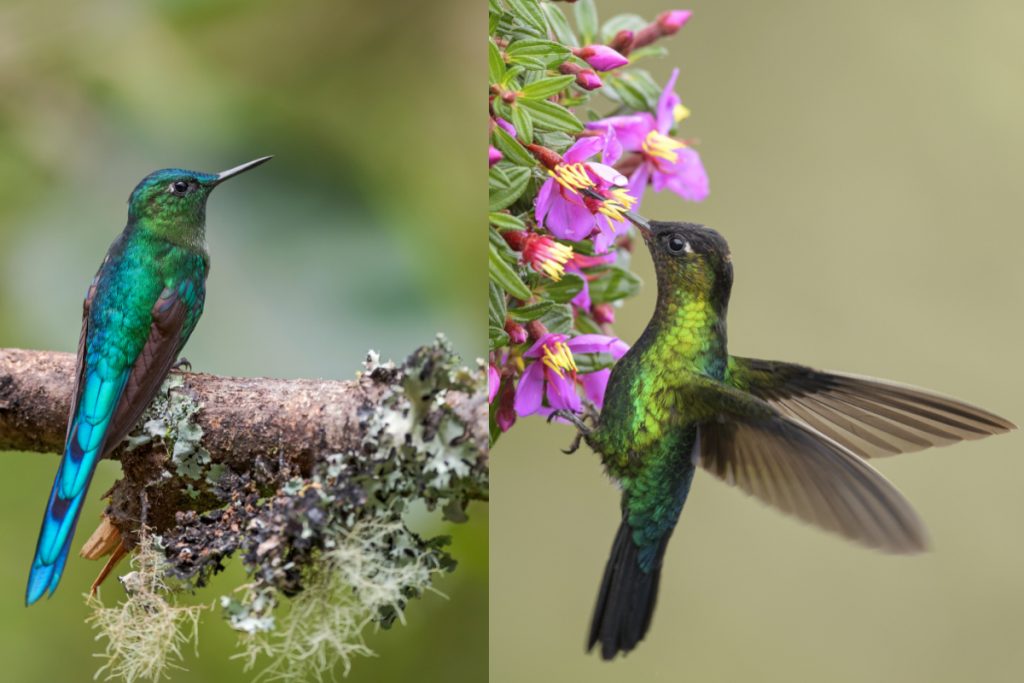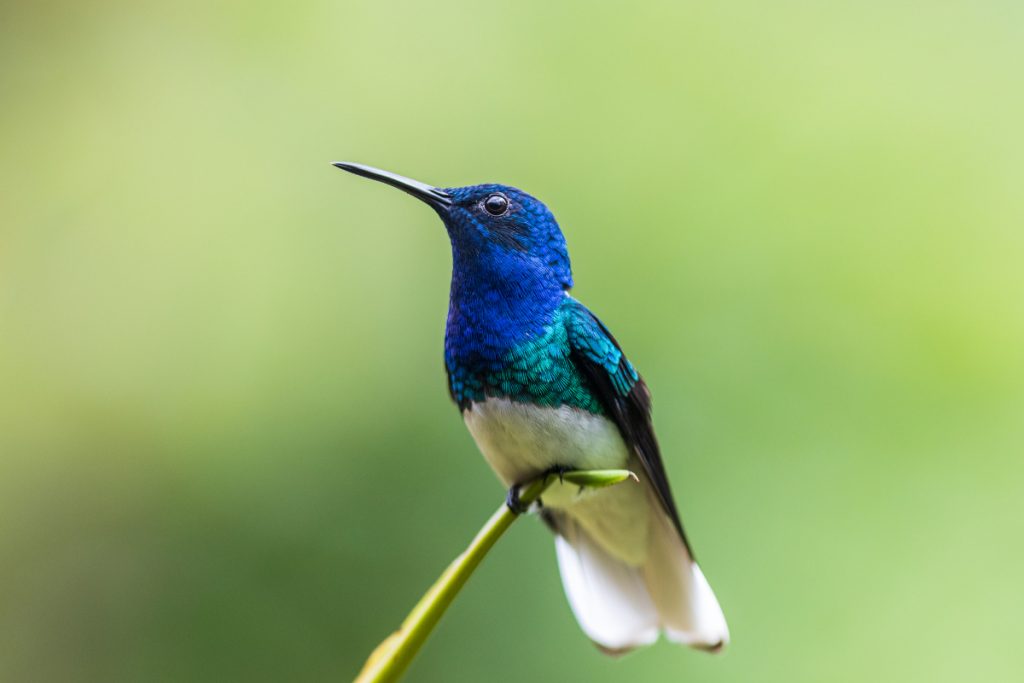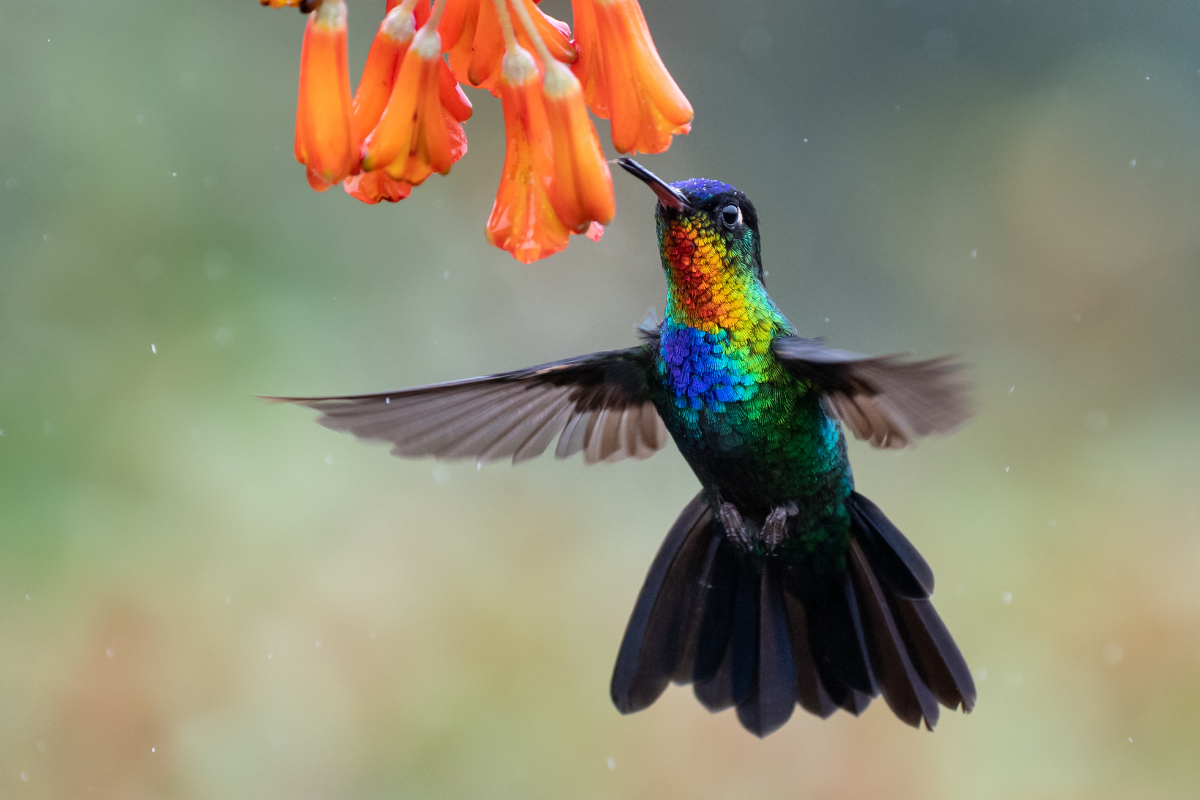In Indiana, hummingbirds typically begin their migration south between late July and September, with most departing by early October. Ruby-throated hummingbirds are the primary species, following specific weather and daylight patterns to time their departure. Some individuals may occasionally overwinter in southern Indiana.
Having said that, the departure time of these hummingbirds will still vary depending on the species. First, let’s understand why they actually leave Indiana every year.
Related post to read about Best Hummingbird Feeders.
Key Takeaways:
- Peak migration occurs in September
- Males depart 2-3 weeks before females and juveniles
- Some birds may stay until first frost.
When Do Different Hummingbirds Leave Indiana?
| Species | Typical Departure | Migration Peak |
| Ruby-throated | Late July – October | Early September |
| Rufous (Rare) | August – September | Late August |
| Allen’s (Rare) | August – September | Late August |
Hummingbird Migration: The seasonal movement of hummingbirds from northern breeding grounds to southern wintering locations, triggered by changes in daylight hours and food availability.
Detailed Migration Timeline
- Late July: Adult males begin departing
- Mid-August: Female departures begin
- September: Peak migration period
- Early October: Final departures
- Post-October: Rare winter residents only.


Why Do Hummingbirds Leave Indiana?
Hummingbird migration is triggered by several factors. Their reasons for leaving Indiana can be attributed to the following factors:
- Instinct: As sunlight decreases and the days become shorter, hummingbirds in Indiana instinctively know it’s time to leave.
- Availability of food: As summer ends, their primary food sources from flowers and insects dry up. Without food, these tiny marvels can’t survive, so they start their search for food in other places.
- Climate: Indiana experiences a blend of humid continental and humid subtropical climates. Simply put, this state witnesses hot, humid, and rainy summers followed by cold, snowy winters. Given hummingbird’s vulnerability to freezing temperatures, they migrate southward in search of tropical regions where they can survive.

What Species Of Hummingbirds Are Commonly Found In Indiana?
The most commonly seen hummingbird in Indiana is the Ruby-throated species. Being native species of the state, you can still find them even after migrating species leave the state. The Ruby-throated hummingbird species is best known for its brilliant iridescent green upperparts, a bright red throat or “gorget” in males, and black wings.
The females have a duller green above and a whitish underside (throat) and are usually bigger.
One significant difference is that the female Ruby-throated hummingbird has no ruby-red throat.
Also, you can find the Allen’s and Rufous hummingbird species migrating through the state in some seasons.
Aside from the common hummingbird species in Indiana, some rare migratory species aren’t usually seen. These include Anna’s, Black-chinned, Broad-tailed, Calliope, and Green-Violetas.
When Do Hummingbirds Arrive In Indiana?
Migrating hummingbirds typically arrive in Indiana by the end of March or early April. The Ruby-throated hummingbird can be found in Indiana all year round, even before other migrating species reach the state.
However, depending on the species, the arrival time of these birds can vary in the state.

Do Hummingbirds Arrive In Different Parts Of Indiana At The Same Time?
An interesting aspect of hummers’ migrating patterns is that they don’t migrate all at once. As solo travellers, these birds don’t travel at the same time, so their arrival time varies.
En route to Northern Indiana, these birds first arrive in the Southern part of Indiana by early April. By mid-April, they reach Central Indiana, and by late April to early May, they grace the northern regions of Indiana with their presence. Therefore, if you’re yet to see them, there’s no cause for alarm; they’re likely on their way and will arrive soon.
Where Are The Best Hummingbird Habitats In Indiana?
You can find these special birds in certain areas of Indiana that have a variety of nectar-rich plants with continuous bloom.
When hummingbirds arrive in Indiana, you can always find them in places where their primary food sources are abundant, like gardens, meadows, and woodlands.

How Can You Attract Hummingbirds in Indiana?
To attract hummers in the Hoosier State, all you have to do is create a welcoming habitat for them. Here are some of the best ways to attract hummingbirds in Indiana:
- Grow native nectar-rich and insect-friendly plants: The primary food source of hummers is the nectar obtained from flowers. So, if you have space for a garden in your backyard, then you can grow a native variety of flowers that are rich in nectar. Since hummingbirds also feed on insects like small bugs and spiders, growing plants that attract insects is a good idea as they provide other nutrients that nectar lacks.
- Provide hummingbird feeders: If you want to attract these delightful birds to your garden but do not have space to grow plants, then you can provide feeders. These feeders can be filled with an easy-to-prepare sugar-water solution and hung outside your apartment window. Consider buying colourful feeders in red, pink and orange shades, as these birds like vibrant colours. But do not use honey, sweeteners or dye the content of the solution, as doing this can harm the birds.
- Provide water sources: Offer these birds shallow water sources like gently-flowing misters as they drink and bathe with them.
- Create habitats: Create habitats that provide shelter and nesting sites for these birds. These shelters can be in the form of trees, tall plants, or shrubs.
Note that even if you have a garden with nectar-rich plants, supplementing with feeders, water sources, and the creation of habitats will increase your chances of attracting these birds.

Which Plants Can You Grow To Attract Hummingbirds In Indiana?
In Indiana, you are sure to attract hummers when you plant nectar-rich and insect-friendly plants. Indiana has a variety of native plants that can be grown for this purpose.
Some of these plants are crossvine, passionflower, trumpet honeysuckle, bee balm, fire pink, passionflower, amongst many others. These plants are not just easy to grow; they are also ideal for your local ecosystem.
When cultivating, ensure that you use only organic pest control methods. The use of chemicals like pesticides, chemical fertilisers, and herbicides can harm hummingbirds.

When Should You Put Out Your Hummingbird Feeders In Indiana?
You should put out your feeders by mid-March to attract the early set of migrating hummingbird species in Indiana.
Typically, male hummingbirds are the first to arrive in Indiana to establish their territories, while the females join them some weeks later.
When Should Hummingbird Feeders Be Taken Down In Indiana?
Late stragglers leave Indiana by the end of October. So, if you don’t notice any hummingbirds at your feeder for up to 2 weeks, it’s safe to take them down by mid-November.
On the other hand, you can leave your feeders out to feed resident species or old and injured birds that can’t migrate during the winter. Just be consistent about cleaning and refilling the feeders to make the solution safe for hummers.

Where Do Indiana Hummingbirds Migrate To In The Winter?
In the winter, lots of hummingbirds from Indiana go to warmer places. They fly to countries like Mexico, Guatemala, Belize, Nicaragua, Honduras, El Salvador, Costa Rica and other countries in Central America. This is because it can get too cold in Indiana, and these birds like warmer weather.
But, like I said before, the Ruby-throated hummingbird will likely remain in the state during wintry weather.
Conclusion
People in Indiana are fortunate because they can see the lovely Ruby-throated hummingbird all year. This bird stays in the state even during winter.
So feel free to leave your feeders out to keep them well-fed during the winter. But remember, you must consistently maintain the feeders to avoid harming your guests.
You can be assured that these migrating hummingbirds will come back in the next seasons. They have great memories and remember every flower or feeder they visited before.
And that’s it on this article; I hope you found it helpful. If you do, please leave your feedback in the comment section below.
Until next time, thanks for reading.

FAQs About When Hummingbirds Leave Indiana
Q: When do hummingbirds typically leave Indiana?
A: Hummingbirds in Indiana usually start their migration at the end of July, and by early October, most have left the state.
Q: Why do hummingbirds leave Indiana in the winter months?
A: During cold weather, their primary food supplies from flowers and insects diminish, and Indiana experiences cold, snowy winters. These factors, along with their instinctual behaviour, push them to migrate to warmer climates for their survival.
Q: Which hummingbird species is commonly found in Indiana year-round?
A: The Ruby-throated hummingbird can be found in Indiana all year round.
Q: How can I attract hummingbirds in Indiana?
A: You can attract hummingbirds by growing native nectar-rich plants, providing hummingbird feeders filled with a sweet solution, offering shallow water sources, and creating habitats with trees, tall plants, or shrubs.
Q: When is the best time to put out feeders in spring for the hummingbirds in Indiana?
A: You should set your feeders by mid-March to attract the earliest migrants.
Q: Where do hummingbirds from Indiana migrate to during the winter?
A: During the winter months, many hummingbirds from Indiana fly to warmer countries in Central America, such as Mexico, Guatemala, and Belize.
Q: Are there hummingbird admirers who report late hummingbird sightings in Indiana?
A: Yes, some late stragglers might be seen in Indiana even until the end of October.
Q: What is the main source of nectar for hummingbirds in Indiana?
A: The primary source of nectar for hummingbirds is from flowers. Hummingbird admirers can also provide fresh nectar using nectar feeders.
Q: How can one prepare the sweet solution for hummingbird feeders?
A: A common mixture involves dissolving a cup of granulated sugar in 4 cups of water.
Q: Why is it important to maintain the feeders regularly?
A: Consistent maintenance ensures that the solution remains safe for the hummingbirds and doesn’t harm them.
Q: Are there any other hummingbirds, apart from the common species, that are seen in Indiana?
A: Rare migratory species like Anna’s, Black-chinned, Broad-tailed, Calliope, and Green-Violetas might occasionally be seen in Indiana.
Q: When is the peak hummingbird season in Indiana?
A: The peak hummingbird season coincides with the summer months when food supplies are abundant and the climate is warm.
Q: When can one expect the earliest migrants to return to Indiana during the spring migration?
A: Migrating hummingbirds typically arrive in Indiana by the end of March or early April.
Q: Do all hummingbirds migrate at the same time of day?
A: No, hummingbirds don’t all migrate at the same time. Their migratory patterns differ, and they travel solo.
Q: Do all parts of Indiana witness hummingbird arrivals at the same time during spring migration?
A: No, the birds first arrive in the Southern part of Indiana by early April, reach Central Indiana by mid-April, and the Northern regions by late April to early May.
Q: How do daylight hours affect hummingbird migration?
A: As sunlight decreases and days become shorter, hummingbirds instinctively know it’s time to leave, indicating the significant role of daylight hours in their migration patterns.
Q: Where are the best hummingbird habitats located in Indiana?
A: Hummingbirds are commonly found in areas with an abundance of nectar-rich plants, like gardens, meadows, and woodlands.
Q: How do I know when to take down the hummingbird feeders for winter?
A: If you don’t notice any hummingbirds at your feeder for up to 2 weeks, it’s safe to take them down by mid-November. However, some might choose to keep them up for resident or injured birds during winter.
Q: Are there any species of hummingbirds native to Indiana?
A: Yes, the Ruby-throated hummingbird is a native breeding hummingbird species of Indiana.
Useful Links:
Related Posts to Read – Hummingbirds Migrations:
- When Do Hummingbirds Leave Ohio?
- When Do Hummingbirds Leave Michigan?
- When Do Hummingbirds Leave Pennsylvania?
- When Do Hummingbirds Leave Florida?
- When Do Hummingbirds Leave Oregon?
- When Do Hummingbirds Leave New York?
- When Do Hummingbirds Leave Oklahoma?
- When Do Hummingbirds Leave Minnesota?
- When Do Hummingbirds Leave South Carolina?
- When Do Hummingbirds Leave Louisiana?
- When Do Hummingbirds Leave Virginia?
- When Do Hummingbirds Leave Texas?
Related Posts to Read:
- Do Hummingbirds Beaks Open When Feeding?
- The Mysteries of Hummingbird Flight.
- 6 Fascinating Facts About Hummingbird Sizes.
- Ruby-Throated Hummingbird Migration Map.
- Where Do Hummingbirds Go When It Rains?
References:
- About Indiana.
- About Hummingbird (Link).
- Greenewalt, C. H. (1960). Hummingbirds. New York: Doubleday. Google Scholar.
- Carey C. The impacts of climate change on the annual cycles of birds. Philos Trans R Soc Lond B Biol Sci. 2009 Nov 27; 364(1534):3321-30. doi: 10.1098/rstb.2009.0182. PMID: 19833644; PMCID: PMC2781852.
- Rico-Guevara A, Rubega MA, Hurme KJ, Dudley R. Shifting Paradigms in the Mechanics of Nectar Extraction and Hummingbird Bill Morphology. Integr Org Biol. 2019 Jan 2;1(1):oby006. doi: 10.1093/iob/oby006. PMID: 33791513; PMCID: PMC7671138.
- Tyrrell LP, Goller B, Moore BA, Altshuler DL, Fernández-Juricic E. The Orientation of Visual Space from the Perspective of Hummingbirds. Front Neurosci. 2018 Jan 30;12:16. doi: 10.3389/fnins.2018.00016. PMID: 29440985; PMCID: PMC5797624.
- Hummingbirds Sighting (Journey North Map).
- About Hummingbird’s Characteristics.
